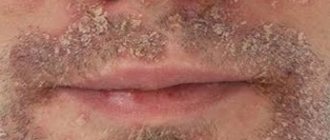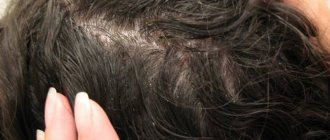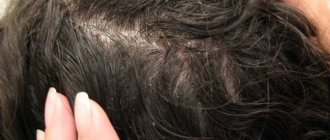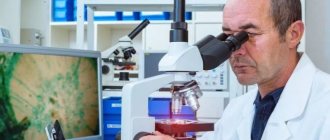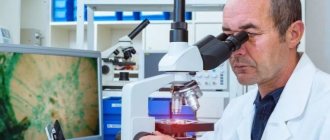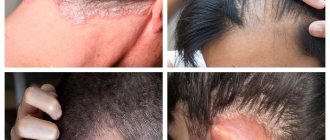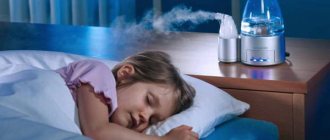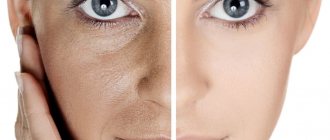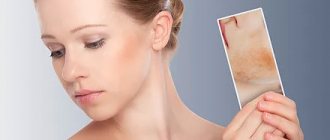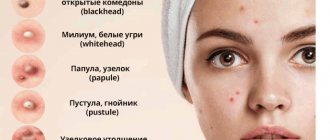A problem that we can observe regardless of the time of year is flaking of the skin on the face. What it is connected with and how to return the skin to a healthy appearance is discussed in this article.
Peeling on the face in itself does not pose a health hazard, but it is a very noticeable aesthetic drawback.
Most often, this problem affects the areas around the nose or around the mouth, but can also occur in other areas of the face.
Fortunately, cosmetologists know well what to do to get rid of this trouble. The treatment prescribed by specialists will allow you to quickly say goodbye to the problem.
Seborrheic dermatitis on the face photo
Photo 1. Seborrheic dermatitis on the face of an adult
Photo 2. Seborrheic dermatitis on the face of an adult
Photo 3. Seborrheic dermatitis
Photo 4. Seborrheic dermatitis on a child’s face
Causes of seborrheic dermatitis on the face
The main cause of seborrheic dermatitis is the increased functioning of the sebaceous glands and a change in the composition of the fat they produce. A similar situation develops when the Malassezia fungus multiplies excessively (normally it is part of the skin microflora). In this case, it penetrates the sebaceous glands and produces a special secretion that forces subcutaneous fat to break down, forming fatty acids that irritate the skin and contribute to the occurrence of rashes.
Dermatitis affects men more often than women, which is explained by the action of androgen, a male hormone. This hormone stimulates the synthesis of subcutaneous sebum. In women, the disease usually manifests itself when estrogen levels decrease and androgen concentrations increase.
Seborrheic dermatitis on the forehead is especially often diagnosed in people whose close relatives have a similar problem, which is associated with a hereditary predisposition.
Other factors can also provoke the development of the disease:
- hormonal imbalances;
- disruption of the endocrine system (especially the thyroid gland);
- weakened immunity;
- hypovitaminosis;
- unfavorable environmental situation;
- improper facial skin care;
- excessive sweating;
- poor nutrition;
- lack of sleep;
- uncontrolled use of medications, especially hormonal ones;
- exacerbation of chronic diseases;
- presence of infection in the body;
- dysfunction of the nervous system, manifested in the form of epilepsy or schizophrenia;
- diabetes;
- pathologies of the gastrointestinal tract;
- frequent stressful situations;
- overwork;
- malignant tumors in the adrenal glands or genitals.
Causes of peeling skin
People with dry skin types are more likely to experience problems with flaking skin on their face. Among the common causes of skin peeling, dermatologists and cosmetologists identify:
- Insufficient moisture intake in the form of clean drinking water;
- Climatic conditions of residence (frequent frosts or aridity);
- Incorrect approach to the level of skin care (moisturizing, washing);
- Selecting cosmetics that do not suit your skin or using alcohol-containing products;
- Allergic reaction of the body to external factors;
- Problems associated with stomach diseases, eczema;
- Failure in the hormonal system;
- Mechanical damage (scratches or cuts).
·
Elimination of the consequences of the above factors is possible only with the use of specialized creams or vitamin complexes.
Symptoms of seborrheic dermatitis on the face
With seborrheic dermatitis on the face, symptoms appear:
- the appearance of pink, red or burgundy spots on the skin;
- the formation of white or yellowish scales and hemorrhagic crusts;
- peeling of the skin;
- irritation and increased sensitivity of the skin;
- itching and burning of varying intensity.
The course of the disease worsens in the autumn. In summer, unpleasant symptoms usually disappear.
If the ducts of the sebaceous glands become clogged, acne appears.
The disease is especially severe in men who grow beards and mustaches. Large plaques form under the hairline, which eventually transform into papules. If an infection occurs, then erythroderma is also detected. When papules coalesce, swollen areas colored red form.
The symptoms of seborrheic dermatitis are similar to those of other dermatological diseases. Therefore, only a doctor can make a correct diagnosis after a thorough examination of the patient.
Causes of peeling skin on the face
Among women
The following reasons most often lead to peeling skin in the fair sex:
- its lack of moisture;
- exposure to sun, wind, cold air;
- carrying out hygiene procedures too frequently;
- using inappropriate cosmetics;
- skin trauma;
- insufficient amount of nutrients;
- allergy;
- dermatological, as well as some other chronic diseases.
In men
The reasons for peeling skin on the face in men are similar to the reasons for this negative phenomenon in women (with the possible exception of abuse of inappropriate cosmetics).
In addition, representatives of the stronger sex are more likely to experience dry skin due to bad habits, as well as systematic exposure to wind and extreme temperatures (for example, due to working outdoors).
How to treat seborrheic dermatitis on the face?
If symptoms of seborrheic dermatitis appear on the face, treatment should be carried out by a specialist. Self-medication can only worsen the condition.
The dermatologist will examine the patient’s skin and refer it for laboratory testing. If necessary, he will advise you to consult a neurologist, endocrinologist, gastroenterologist, andrologist or gynecologist. Based on the diagnostic results, the doctor will select the optimal treatment, which should be comprehensive. First, the dermatologist prescribes weak drugs. If they do not produce the desired result, then he moves on to potent ones.
To effectively cope with the disease, it is imperative to identify and eliminate the cause of the disease. If dermatological problems are caused by disturbances in the digestive system, the patient is referred to a gastroenterologist. After the examination, he will prescribe suitable medications, most often enzymes, sorbents and choleretic agents. Enzymes and choleretic drugs will restore the functioning of the gastrointestinal tract, and sorbents will remove toxic substances from the body.
Typically, treatment for nasal dermatitis includes:
- compliance with the diet prescribed by a specialist;
- drug therapy;
- physiotherapy;
- maintaining personal hygiene using gentle products.
Drug therapy involves taking:
- antihistamines - relieve itching;
- probiotics – restore intestinal microflora and normalize the functioning of the digestive tract;
- vitamin complexes – strengthen the immune system and increase the body’s resistance.
In addition to medications intended for oral use, external agents that have a moisturizing, anti-inflammatory and antifungal effect are recommended.
Both glucocorticosteroid hormonal ointments and non-hormonal drugs can be used. But you need to know that glucocorticosteroids, although they have an effective effect (relieve inflammation, swelling and redness), but they are addictive and, with prolonged use, provoke side effects (vasodilatation, the formation of rosacea and telangiectasia, the development of erythema).
Therefore, it is better to give preference to non-hormonal drugs, among which the products of the “Losterin” series (cream, ointment, gel, shampoo) have shown particular effectiveness. They are characterized by a neutral composition, do not contain hormones, do not irritate the skin and are not addictive. The drugs included in the “Losterin” line can be used not only by adults, but also by newborn babies. They are recommended for daily use both during remission and during acute inflammation. Active substances (naphthalan, salicylic acid, natural oils, medicinal plant extracts) are included in the composition of “Losterin” products in optimal proportions, which determines the most effective therapeutic effect. Even if seborrheic dermatitis has passed, Losterin should continue to be used to prevent a relapse.
Physiotherapeutic procedures can effectively complement drug treatment. Small doses of ultraviolet light will ease the course of the disease, restore the functioning of the sebaceous glands, and relieve redness, swelling and itching.
How to get rid of peeling skin on your face
The answer to the question of what helps with severe peeling is simple. Of course, these are cosmetic procedures selected by a specialist.
However, it is important to remember: after completing the course of treatment selected by a cosmetologist, in no case should you forget about proper home facial care. Only then will the likelihood of the problem reoccurring be minimized.
Biorevitalization
Biorevitalization is an injection of hyaluronic acid and other beneficial substances.
This technique can significantly improve the condition of the skin, getting rid of the first signs of aging, hyperpigmentation, rosacea, uneven turgor and some other problems.
Biorevitalization practically does not cause side effects or allergic reactions, and to get rid of peeling, as a rule, no more than three procedures are required. In this case, the positive changes will remain for at least six months, and to make the effect longer, it will be enough to carry out maintenance injections once a quarter.
Mesotherapy
This technique consists of the injection of a meso-cocktail - a composition from a whole complex of useful elements, selected based on indications. This procedure allows you to achieve natural hydration, increase tone and turgor, and eliminate minor cosmetic defects.
Among the contraindications to mesotherapy:
- pregnancy;
- lactation period;
- dermatological diseases in the area of planned exposure;
- bleeding disorders;
- kidney failure and some other serious diseases;
- taking a number of medications.
For peeling skin, the following mesotherapy drugs are most effective:
- F-DMAE 3%;
- F-XFC face;
- NCT-Hyal Revitalizing CX.
Prevention of seborrheic dermatitis on the face
To prevent dermatitis on the forehead from causing a relapse, it is recommended to follow several rules:
- strengthen the immune system;
- cleanse the body of waste and toxins;
- exclude from the diet salty and spicy foods, fatty and smoked foods, marinades, spices and condiments, sweets, chips and crackers, products containing preservatives, flavor enhancers and dyes;
- introduce fermented milk products into the menu, which include lacto- and bifidobacteria, animal proteins, bran, buckwheat, oatmeal;
- cook food with vegetable oil;
- restore the functioning of the digestive system.
Who is guilty…
First, let's figure out what dandruff is. Unfortunately, this is not just an aesthetic problem - this phenomenon is based on a fungus that disrupts the functioning of the sebaceous glands. Small dead scales of the upper layer of the epithelium appear where the skin is covered with a large amount of hair or hair follicles and sebaceous glands. So, in principle, a beard is a very favorable place for dandruff to appear.
So, if the cause of dandruff is a malfunction of the sebaceous glands, then what can trigger it? We are all familiar with the risk factors - few people can boast that they are doing well on all these points:
- Chronic stress, overwork, which affects the entire body. This also includes violations of the daily routine, lack of sleep, and lack of fresh air. Poor nutrition – excess fatty, spicy, spicy foods. Dandruff can also be caused by eating too hot food and drinking too much scalding coffee.
- Hormonal disbalance.
- Vitamin deficiency, as well as a lack of minerals and proteins in the diet.
- Excessive tanning – the sun burns and dries the skin.
- Inappropriate facial skin care - lack of hydration, excess alcohol products that dry out the skin. Sometimes just adding a moisturizer to your skincare routine can solve the problem. Exfoliating masks and scrubs are also welcome - they solve aesthetic problems and will help you finally get rid of the dead skin layer and remove unsightly white flakes.
- Inaccurate hair removal - using a dull old razor. If this is the case, try replacing the tool with something more modern: for example, the Dorco Pace 6 is complemented by a lubricating strip with natural aloe vera extract, argan oil and vitamin E, which helps get rid of irritation after shaving, and six sharp curved blades remove all unwanted hair in just one movement. The rubber micro-comb lifts the hairs before shaving and ensures a perfectly even cut.
Pace 6
;
Cope with any soft or hard stubble
